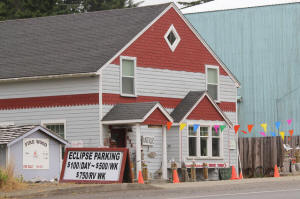|
Millions of Americans to gaze upon
Monday's once-in-a-lifetime eclipse
 Send a link to a friend
Send a link to a friend
 [August 19, 2017]
By Steve Gorman [August 19, 2017]
By Steve Gorman
(Reuters) - Twilight will fall at midday on
Monday, stars will glimmer and birds will roost in an eerie stillness as
millions of Americans and visitors witness the first total solar eclipse
to traverse the United States from coast to coast in 99 years.
The sight of the moon's shadow passing directly in front of the sun,
blotting out all but the halo-like solar corona, may draw the largest
live audience for a celestial event in human history. When those
watching via broadcast and online media are factored into the mix, the
spectacle will likely smash records.
"It will certainly be the most observed total eclipse in history,"
astronomer Rick Fienberg of the American Astronomical Society (AAS) said
last week.
The eclipse begins its cross-country trajectory over the Pacific Coast
of Oregon in late morning. It will reach South Carolina's Atlantic shore
some 90 minutes later.
The total eclipse of the sun is considered one of the most spell-binding
phenomena in nature but it rarely occurs over a wide swath of land, let
alone one of the world's most heavily populated countries at the height
of summer.

In terms of audience potential, it is hard to top the United States,
with its mobile and affluent population, even though the direct path is
mostly over rural areas, towns and small cities. The largest is
Nashville, Tennessee, a city of 609,000 residents.
Even so the advent of social media and inexpensive high-tech optics have
boosted public awareness, assuring what many U.S. experts predict will
be unprecedented viewership for the so-called "Great American Eclipse."
Some might take issue with that prediction, citing a solar eclipse
visible over parts of India, Nepal, Bangladesh and central China in July
2009. National Geographic estimated 30 million people in Shanghai and
Hangzhou alone were in its path that day.
On Monday, the deepest part of the shadow, or umbra, cast by the moon
will fall over a 70-mile-wide (113-km-wide), 2,500-mile-long
(4,000-km-long) "path of totality" traversing 14 states. The 12 million
people who live there can view the eclipse at its fullest merely by
walking outside and looking up, weather permitting.
LIVESTREAMING AND PRICE-GOUGING
Some 200 million Americans reside within a day's drive of the totality
zone, and as many as 7 million, experts say, are expected to converge on
towns and campgrounds along the narrow corridor for the event. Many are
attending multi-day festivals featuring music, yoga and astronomy
lectures.

[to top of second column] |

A parking sign for people visiting for the Solar Eclipse is shown in
Depoe Bay, Oregon, U.S. August 9, 2017. Picture taken August 9,
2017. REUTERS/Jane Ross

Millions more could potentially watch in real time as the eclipse is
captured by video cameras mounted on 50 high-altitude balloons and
streamed online in a joint project between NASA and Montana State
University. A partial eclipse will appear throughout North America.
Adding further to the excitement is the wide availability of
affordable solar-safe sunglasses produced by the millions and
selling so fast that suppliers were running out of stock.
The owner of one leading manufacturer reported price gouging by
second-hand dealers who were buying up large supplies in and
reselling them over the internet at a huge mark-up.
Not all the hoopla will unfold on dry land. Welsh pop singer Bonnie
Tyler is slated to perform her 1983s hit single "Total Eclipse of
the Heart" aboard a cruise liner as the vessel sails into the path
of totality from Florida on Monday.
Back on the ground, forest rangers, police and city managers in the
total eclipse zone are bracing for a crush of travelers they fear
will cause epic traffic jams and heighten wildfire hazards.
"Imagine 20 Woodstock festivals occurring simultaneously across the
nation," Michael Zeiler, an AAS advisory panel member wrote on his
website, GreatAmericanEclipse.com, referring to the famously chaotic
1969 outdoor rock extravaganza in upstate New York.
Zeiler, an avowed "eclipse chaser" who made the 650-mile (1,046 km)
drive from his New Mexico home to Wyoming for a choice view, said
South Carolina is likely to see the greatest influx as the
destination state closest to the entire U.S. Eastern seaboard.

Monday's event will be the first total solar eclipse spanning the
entire continental United States since 1918 and the first visible
anywhere in the Lower 48 states in 38 years.
The next one over North America is due in just seven years, in April
2024.
(Reporting by Steve Gorman in Los Angeles; Editing by Frank McGurty
and Sandra Maler)
[© 2017 Thomson Reuters. All rights
reserved.]
Copyright 2017 Reuters. All rights reserved. This material may not be published,
broadcast, rewritten or redistributed. |